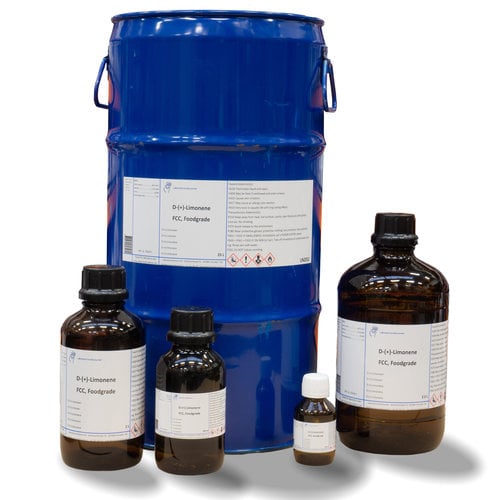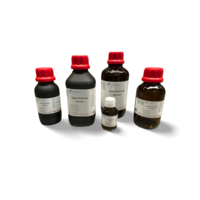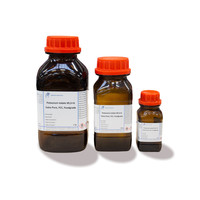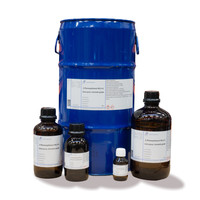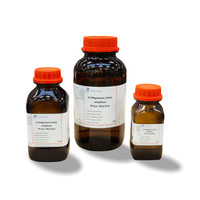You have no items in your shopping cart
D-(+)-Limonene FCC, Foodgrade
- Buy 2 and save 5%
- Buy 6 and save 10%
What is limonene?
Limonene is a natural substance extracted from the oil of citrus peels that gives them their characteristic scent. It belongs to the group of terpenes, specifically limonoids, which form one of the broadest classes of functional foods and phytonutrients, which act as antioxidants.
It has an asymmetric carbon as its stereocenter. So there are two optical isomers: D-limonene and L-limonene.
Limonene can be distilled from this oil using various techniques and used in food and as a natural degreaser. The extraction and distillation processes are carried out in all citrus producing regions of the world to meet the increasing demand. Recently, microwave energy has been proposed for its azeotropic distillation, used for the extraction of fats and oils, this technique being considered an efficient method as it offers short extraction times (only 30 minutes compared to 3 hours in the conventional method), it also assumes low cost and low by-product production (compared to conventional distillation)
What is limonene used for?
In recent years, it has gained special importance due to its demand as a biodegradable solvent. Besides being an industrial solvent, it also has uses as an aromatic component and is widely used to synthesize new compounds.
Being a derivative of citrus fruits, limonene is considered a clean and environmentally friendly heat transfer agent, which is why it is used in many pharmaceutical and food processes.
Limonene is widely used in the household cleaning industry, the food industry and cosmetics, in part because its aroma is pleasant. For example, it is also used in a solvent for resins, pigments, inks, paints, in the manufacture of adhesives, as an additive in fragrances, in coolants, as an odor control agent, etc. It is also used by the pharmaceutical and food industries as a flavoring and flavoring agent , for example in obtaining artificial mint flavors and in the manufacture of candies, chewing gums, beverages and spices.
Limonene is also used as an insecticide to repel or kill ants, aphids, mealybugs, flies, mites, cockroaches, wasps, rosebushes, ornamental plants...as it is not toxic to humans and pets nor harmful to gardening , plants indoors or for the environment so it can be used in homes, offices and schools. Being the composition of the insectida: d-limonene, a non-toxic hydrophilic solvent and a non-toxic emulsifier to dissolve the d-limonene in said solvent.
Because it is so poorly miscible with water, it is used as a floating degreaser for use in sewage pumping stations and as a parts and immersion tank degreaser. In degreasing applications, the relatively high solvent power implies the use of small volumes. However, due to their low volatility, drying times tend to be longer than with the more commonly used chlorinated solvents. D-limonene is considered a replacement for methyl ethyl ketone, acetone, toluene, xylene and many chlorinated solvents (chlorinated hydrocarbons and chlorofluorocarbons). However, in chemical synthesis applications, the reactivity of the C=C double bond must be taken into account. There is also concern that this could lead to solvent degradation.
Limonene has recently been used in rice bran oil extraction as an alternative to hexane, which is often used in such processes. The yield and quality of raw rice bran oil obtained from limonene extraction is almost equal to that obtained with hexane. In addition, the solvent is potentially recyclable in these processes.
Limonene has also been used with interesting results in polymer chemistry, but it remains to be seen whether its chirality can be used to elicit similar effects in small molecule synthesis.
Various products and intermediates can be synthesized from limonene, but perhaps the most important is P-cymene (through the catalytic dehydrogenation of limonene), which has applications in fragrances, polymers (PET), the pharmaceutical industry and as a solvent.
Another limonene-derived component of great importance is perillyl alcohol, a cyclic monoterpene found in trace amounts in lavender, spearmint, spearmint, and caraway essential oils. It is a relatively non-toxic agent used for preclinical testing for its therapeutic properties.
Buy Limonene?
You can buy limonene at Laboratoriumdiscounter, not only are our limes of food-grade quality, but they are also competitively priced! So if you need limonene you have come to the right place at Laboratoriumdiscounter.nl! Shipped throughout Europe and delivered quickly! The best quality limes and food grade certified! Only at Laboratory Discount!
Technical properties
Molar mass (M) 136,24 g/mol
Density (D) 0,84 g/cm³
Boiling point (bp) 178 °C
Flash point (flp) 51 °C
Melting point (mp) -74 °C
Storage temp. +4 °C
ADR 3 III
WGK 2
CAS No. 5989-27-5
EG-Nr. 227-813-5
UN-Nr. 2052
Downloads
Hazard statements
H226 Flammable liquid and vapour
H304 May be fatal if swallowed and enters airways
H315 Causes skin irritation
H317 May cause an allergic skin reaction
H410 Very toxic to aquatic life with long lasting effects
Precautionary statements
Precautionary statements - prevention
P210 Keep away from heat, hot surfaces, sparks, open flames and other ignition sources. No smoking
P273 Avoid release to the environment P280 Wear protective gloves/eye protection
Precautionary statements - response
P302+P352 IF ON SKIN: Wash with plenty of soap and water





